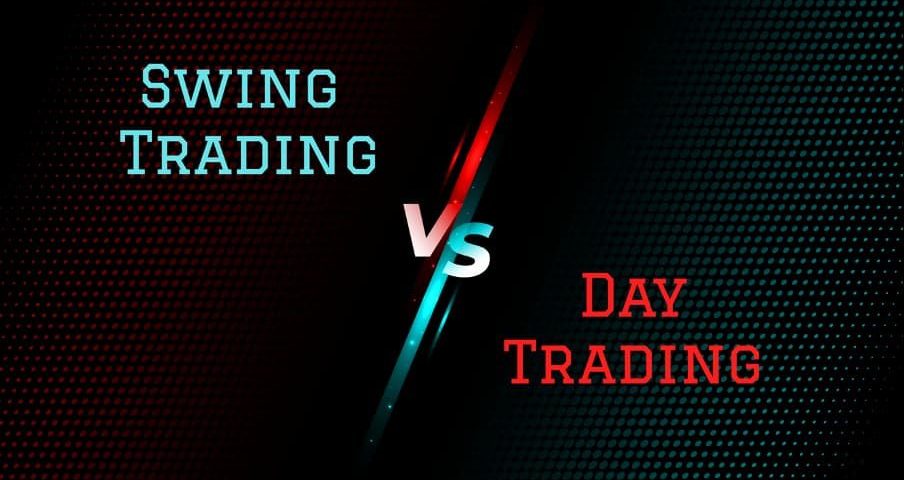
How to Trade Stocks: A Comprehensive Guide
August 29, 2024
Top 8 and Best Trading Strategies
August 30, 2024Day Trading vs Swing Trading: Which is Better?

day trading vs swing trading
Introduction to Day Trading vs Swing Trading
When it comes to trading in the financial markets, two popular strategies often come up: day trading and swing trading. While both aim to make profits from short-term price movements, they differ significantly in approach, time commitment, risk level, and the skills required. This article will provide an in-depth comparison of day trading and swing trading to help you decide which strategy may be best suited for you.
What is Day Trading?
Day trading is a trading style where all positions are opened and closed within the same trading day. This means traders do not hold any positions overnight, avoiding the risks associated with after-hours market movements. Day traders capitalize on small price fluctuations in high-volume stocks or forex pairs, often making multiple trades in a single day.
Key Features of Day Trading
- Short-Term Focus: Day traders focus on very short time frames, such as minutes or hours.
- High Frequency of Trades: They may execute dozens or even hundreds of trades in a single day.
- Leverage Usage: Many day traders use leverage to maximize returns on small price changes.
- Quick Decision-Making: Requires quick decision-making skills and the ability to act on market changes in real-time.
Tools and Platforms for Day Trading
To succeed in day trading, you need access to powerful tools and platforms. These often include real-time data feeds, advanced charting software, and fast execution capabilities to ensure trades are completed quickly and efficiently.
What is Swing Trading?
Swing trading involves holding positions for several days to weeks to capture potential price swings in the market. Unlike day traders, swing traders hold onto their assets beyond a single day, aiming to profit from broader market movements.
Key Features of Swing Trading
- Medium-Term Focus: Swing traders focus on longer time frames compared to day traders, such as days to weeks.
- Fewer Trades: They make fewer trades, allowing for a more relaxed trading pace.
- Trend Following: Swing traders often follow market trends and look for continuation patterns.
- Less Time-Intensive: This strategy does not require constant monitoring, making it more suitable for part-time traders.
Tools and Platforms for Swing Trading
Swing traders typically use platforms that provide comprehensive charting tools, news updates, and indicators for both technical and fundamental analysis.
Day Trading vs Swing Trading: A Detailed Comparison
Time Commitment Required
Day Trading: A Full-Time Job
Day trading demands a significant time commitment. It is often considered a full-time job, as traders need to monitor the markets constantly throughout the trading day to spot opportunities and manage risks.
Swing Trading: Flexibility in Time Management
Swing trading offers more flexibility since positions are held for a longer period. Traders can analyze the market during their free time, making it an ideal choice for those who cannot dedicate full-time hours to trading.
Risk and Reward Potential
High Risks with Day Trading
Day trading can be highly lucrative, but it also comes with high risks. The use of leverage can magnify both gains and losses. The fast-paced nature of day trading means that traders can lose substantial amounts of money very quickly.
Risk Management in Swing Trading
Swing trading involves holding positions for longer periods, which can reduce the impact of short-term market volatility. While it is generally less risky than day trading, the potential for reward is also typically lower per trade.
Capital Requirements
Capital Needed for Day Trading
Day traders often need a significant amount of capital to be profitable, especially due to margin requirements and the cost of frequent transactions. The minimum equity required by the U.S. Securities and Exchange Commission (SEC) for pattern day traders is $25,000.
Capital Needed for Swing Trading
Swing trading typically requires less initial capital compared to day trading. Since traders make fewer trades, they incur fewer transaction costs. However, they still need enough capital to withstand market fluctuations and avoid forced liquidation.
Skills and Knowledge Required
Essential Skills for Day Trading
Day trading requires advanced technical analysis skills, quick reflexes, and the ability to remain calm under pressure. A deep understanding of market mechanics, chart patterns, and trading psychology is essential.
Essential Skills for Swing Trading
Swing trading relies more on a combination of technical and fundamental analysis. Swing traders should have a good grasp of both disciplines and be able to spot potential trend reversals and continuation patterns.
Technical and Fundamental Analysis: The Key to Both
Regardless of the trading style, proficiency in technical and fundamental analysis is crucial. Day traders may rely more heavily on technical indicators, while swing traders often incorporate broader market trends and economic indicators.
Pros and Cons of Day Trading
Advantages of Day Trading
- No Overnight Risk: Positions are closed by the end of the day, reducing exposure to after-hours market events.
- High Earning Potential: With proper strategy and skills, day traders can earn significant profits quickly.
- Fast-Paced Environment: Ideal for those who enjoy quick decision-making and a dynamic trading environment.
Disadvantages of Day Trading
- High Risk and Volatility: Significant potential for loss, especially when using leverage.
- Time-Consuming: Requires constant monitoring of the markets, making it unsuitable for those with other full-time commitments.
- Stressful: The fast-paced nature can be mentally and emotionally taxing.
Pros and Cons of Swing Trading
Advantages of Swing Trading
- Flexibility: Can be done part-time, allowing for other commitments.
- Lower Risk per Trade: Generally involves less risk than day trading due to longer time frames.
- Less Stressful: Less need for constant market monitoring.
Disadvantages of Swing Trading
- Overnight Risk: Holding positions overnight exposes traders to unexpected market events.
- Lower Profit Potential per Trade: May not offer the same quick profit potential as day trading.
Choosing Between Day Trading and Swing Trading
Factors to Consider When Choosing a Trading Style
Personality and Lifestyle
If you enjoy a fast-paced, dynamic environment and can dedicate full-time hours to trading, day trading might be a good fit. If you prefer a more relaxed approach with the flexibility to trade part-time, swing trading could be better suited for you.
Financial Goals and Risk Tolerance
Your financial goals and risk tolerance are crucial in deciding between the two. Day trading may offer higher potential rewards but comes with greater risks, while swing trading offers a more balanced risk-reward ratio.
Conclusion
Choosing between day trading and swing trading depends on your personal preferences, time commitment, risk tolerance, and financial goals. Both strategies have their pros and cons, and the best choice will vary for each individual. Consider your lifestyle, trading style, and market understanding before making a decision.
FAQs
What is the main difference between day trading and swing trading?
Day trading involves buying and selling securities within a single day, while swing trading involves holding positions for several days to weeks to capitalize on short-to-medium-term market movements.



